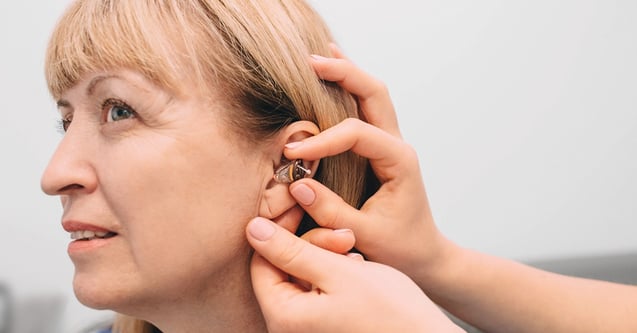
There are many factors as to how we lose our hearing, including exposure to loud noises, ear infections, ruptured eardrums and aging. And of the 48 million Americans affected by hearing loss, it is believed that nearly 29 million of them would benefit from the use of a hearing aid.
If hearing aids are an option you are considering, we have developed this comprehensive guide that covers everything from how they work, to the various options on the market and even some easy ways you can mitigate hearing damage right now.
Before we begin, we want to remind you that this article is meant to arm you with helpful knowledge so you can work with your doctor. They will be able to provide the best course of action that works best for your situation.
How hearing aids work
As the name suggests, hearing aids are small electronic devices that can be worn inside of the ear or behind it to help make sounds louder so the user can better communicate with others and participate in activities.
They are typically made up of three parts: a microphone, amplifier and speaker that work in tandem with each other. The hearing aid receives sound through a microphone, which converts those sound waves into electric signals that get sent to the amplifier. The amplifier then increases the power of those signals and sends them to the ear through a speaker, completing the cycle.
The different types of hearing aids
Though there are hundreds of hearing aids on the market, they typically come in one of four types:
- Behind-the-ear (BTE): BTE hearing aids rest behind the ear and are connected to an earmold that shapes around your ear. All of the components—battery, microphone and controls—are also situated externally, which makes the BTE easy to handle and maintain. These are recommended for hearing loss ranging from mild to profound.
- In-the-canal (ITC): The ITC variant is a lightweight shell that sits inside the ear canal. Though their smaller size may make them harder to use, they are known for their comfort since they are made to the size and shape of your ear. This type is best served for those with moderate to severe hearing loss.
- In-the-ear (ITE): Unlike ITC hearing aids, ITE types are larger, which makes them easier to handle since they fill the outer part of the ear instead of nestling inside of the canal. This variant has the ability to install a telecoil, which receives sound through the circuitry of the hearing aid instead of a microphone, allowing for clearer sound. ITEs are a good option for those with mild to severe hearing loss.
- Receiver-in-canal (RIC): For those with less profound hearing loss and are looking for a near-invisible option, the RIC model could be a good fit. The receiver is small in stature and the tube can barely be seen inside of the ear. This variant is best for mild to moderate hearing loss.
What hearing aids cost and how to afford them
The price of hearing aids is going to vary greatly based on the level of technology involved. The more bells and whistles hearing aids have, such as invisible components, seamless controls and wireless functionality, the more you can expect to pay. Prices can range from $1,000 to upwards $6,000 per ear depending on these factors.
While most private insurance companies and Medicare do not cover hearing aids, you do have options to help afford the care you need. For instance, a wellness discount card such as Wellness Complete can save you money with a participating provider.
There are also organizations that may be able to help with the cost of hearing aids, including the Department of Veteran Affairs, Easter Seals or a local community health center. Medicaid may also help cover hearing aids depending on where you live and you can find a complete state-by-state directory here.
Easy ways to protect your hearing
Whether you need hearing aids or not, it is important to protect your hearing from future problems you could experience down the road. Here are some quick, easy ways you can mitigate hearing damage right now.
- Don’t use cotton swabs to clean your ears: Even though the packaging might say you can use cotton swabs to clean your ears, don’t do it. Wax works naturally to clean your ears out and sticking foreign objects in your ear could cause some serious problems. At best, you could push in earwax that will harden and will need to be extracted out by a doctor and/or the use of specialized ear drops. At worst, you can rupture an eardrum or cause permanent damage.
- If possible, choose over-ear headphones over earbuds: This advice covers two fronts. From an auditory perspective, you are placing two tiny speakers directly into your ear with nothing between them. While this is fine for low volumes, extended listening on loud volumes can cause hearing loss. And similar to cotton swabs, earbuds can also cause wax blockage that can affect hearing and cause tinnitus.
- Move your body: Exercise gets your blood pumping everywhere, including your ears. Whether you go for a walk around the block or hop on your bike for an easy ride, getting blood flow to your ears will help keep the internal parts healthy and in working order.
The bottom line: Hearing aids come in four different varieties and your doctor can help you find the one that is best for your unique situation based on your level of hearing loss and budget. Even without insurance covering hearing aids, you still have options to explore, including wellness discount cards. Regardless if you need hearing aids or not, there are easy things you can do right now to prevent damage to your hearing.
